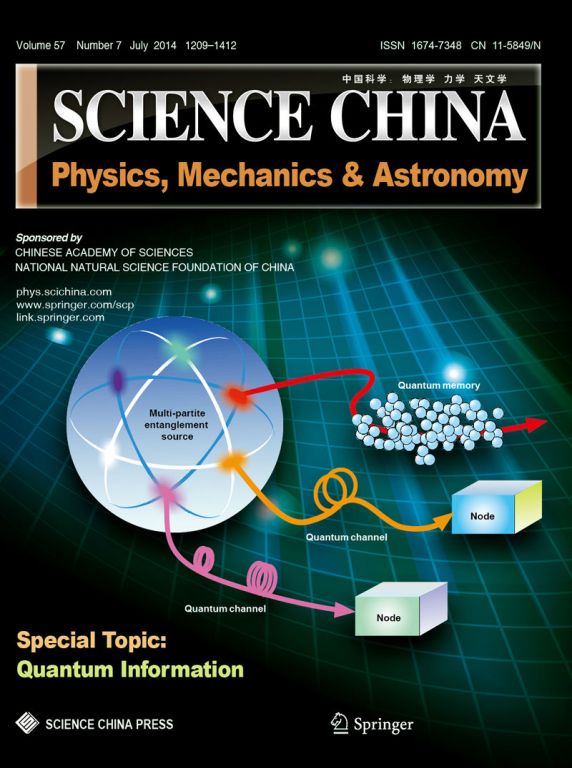博文
《中国科学: 物理学力学天文学》英文版出版量子信息专题
|
《中国科学: 物理学力学天文学》英文版出版量子信息专题
特邀编辑:龙桂鲁,潘建伟
SCIENCE CHINA Physics, Mechanics & Astronomy 2014, Volume 57, Issue 7
Special Topic: Quantum Information
http://phys.scichina.com:8083/sciGe/EN/volumn/volumn_6467.shtml
 Cover Quantum information science promises superpowered capacities of computation, communication and metrology for the future. Quantum networks play a key role for realizing the physical implementation of quantum information science. In a quantum network, quantum information is generated, processed and stored locally at individual nodes which are linked by quantum channels. The carriers of quantum information are quantum states. To transport quantum states from node to node in a network we have to distribute quantum entanglement across the entire network in advance. For storing, processing and transmitting quantum information in networks quantum states are converted from a physical system to another one in a reversible manner, which can be achieved by the interaction of light and atoms at nodes. The front cover painting is a schematic of quantum networks, in which the multi-partite entangled optical modes are generated by an entanglement source and distributed to different nodes. The preparation of multi-partite entangled states is an essential step for constructing a quantum network. In the paper we review the experimental progress in the generation of multi-partite and multi-color optical entangled states with continuous quantum variables. These types of quantum entanglement provide the necessary resource for establishing continuous variable quantum information networks (See the review by SU XiaoLong et al. on page 1210).
Cover Quantum information science promises superpowered capacities of computation, communication and metrology for the future. Quantum networks play a key role for realizing the physical implementation of quantum information science. In a quantum network, quantum information is generated, processed and stored locally at individual nodes which are linked by quantum channels. The carriers of quantum information are quantum states. To transport quantum states from node to node in a network we have to distribute quantum entanglement across the entire network in advance. For storing, processing and transmitting quantum information in networks quantum states are converted from a physical system to another one in a reversible manner, which can be achieved by the interaction of light and atoms at nodes. The front cover painting is a schematic of quantum networks, in which the multi-partite entangled optical modes are generated by an entanglement source and distributed to different nodes. The preparation of multi-partite entangled states is an essential step for constructing a quantum network. In the paper we review the experimental progress in the generation of multi-partite and multi-color optical entangled states with continuous quantum variables. These types of quantum entanglement provide the necessary resource for establishing continuous variable quantum information networks (See the review by SU XiaoLong et al. on page 1210).
Quantum communication and quantum computation are two major branches of quantum information. In quantum communication, principles of quantum physics provide us with the capability of on-site detection of eavesdropping (ODE). In quantum key distribution, random numbers are distributed between two remote parties. If an eavesdropper is found, then the communicated data will be discarded. If no eavesdropper is found, the transmitted data is then post-processed to a very high security level and used as keys. Quantum key distribution could not communicate secret message directly, because it cannot obliterate the information leakage before eavesdropper detection (OILBED). In quantum secure direct communication, not only eavesdropper can be found on-site, but also the obliteration of information leakage before eavesdropper detection can be realized. OILBED makes quantum secure direct communication to transmit secret messages directly. If the communication is bi-directional, then it becomes a quantum dialogue. It is believed that a global quantum network could be built by running intra-city quantum communication with fibers, and the inter-city quantum communications by the use of ground-satellite, satellite-satellite, and satellite-ground links. On the other hand, quantum principles enable quantum computer to compute or process much more powerfully. The Shor algorithm, the Grover algorithm and simulations of quantum systems are three major quantum algorithms. The simulation of quantum systems is one of the important application of quantum computation in quantum computers with just a few quantum bits. In such prototype system, quantum algorithms can be demonstrated and studied.
This special topic of SCIENCE CHINA Physics, Mechanics & Astronomy collected eight papers. To be ready with satellite-ground quantum key distribution, Wang et al. [1] completed an experimental validation work on dynamic polarization compensation. Su et al. [2] presented their work on the preparation of entangled states for quantum network. Liang et al. [3] reviewed the recent development on single-photon detection, a critical component in quantum communication and quantum computation. New protocols have also been studied. Zheng et al. [4] presented a protocol of quantum dialogue. Gao et al. [5] reported their minimum best success probability result in quantum telegraphy. Quantum simulation of “zitterbewegung” using ion-trap scheme is proposed by Liu et al. [6]. An experimental realization of the quantum deletion algorithm was given by Long et al. [7]. Finally, Zhao et al. [8] studied the long time evolution of a spin in a spin bath, an important result that could help to find a new candidate for quantum memory or quantum computation.
This special topic is only part of the efforts of the Chinese quantum information community at present. We hope this special issue will reflect the on-going research effort of the quantum information community in China, and help to stimulate the efforts and draw attention of respective researchers.
Prof. LONG GuiLu
Department of Physics, Tsinghua University
Prof. PAN JianWei
Department of Modern Physics, University of Science and Technology of China
1 Wang C Z,Guo H,Ren J G,et al. Experimental validation of dynamic polarization compensation in ground-satellite quantum key distribution. Sci China-Phys Mech Astron, 2014, 57(7): 1233–1237 PDF
2 Su X L, Jia X J, Xie C D, et al. Preparation of multipartite entangled states used for quantum information networks . Sci China-Phys Mech Astron, 2014, 57(7): 1210–1217 PDF
3 Liang Y, Zeng H P. Single-photon detection and its applications. Sci China-Phys Mech Astron, 2014, 57(7): 1218–1232 PDF
4 Zheng C, Long G F. Quantum secure direct dialogue using Einstein-Podolsky-Rosen pairs. Sci China-Phys Mech Astron, 2014, 57(7): 1238–1243 PDF
5 Gao F, Fang W, Wen Q Y. Minimum best success probability by classical strategies for quantum pseudo-telepathy. Sci China-Phys Mech Astron, 2014, 57(7): 1244–1249 PDF
6 Liu T, Feng M, Yang W L, et al. Quantum simulation of‘zitterbewegung’ in a single trapped ion under conditions of parity-keeping and parity-breaking. Sci China-Phys Mech Astron, 2014, 57(7): 1250–1255 PDF
7 Long Y, Feng G R, Pearson J, et al. Experimental quantum deletion in an NMR quantum information processor. Sci China-Phys Mech Astron, 2014, 57(7): 1256–1261 PDF
8 Zhao Y K, Zhao M S, Chen Z B. Long time evolution of a spin interacting with a spin bath in arbitrary magnetic field. Sci China-Phys Mech Astron, 2014, 57(7): 1262–1265 PDF

https://blog.sciencenet.cn/blog-306503-798008.html
上一篇:基于离散空间直接建模的多尺度流动数值模拟新方法
下一篇:如何提高非接触光学方法测量壁面摩阻的精度?